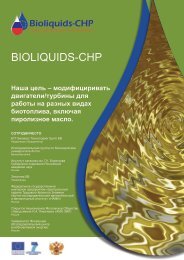Project summary - Bioliquids-CHP
Project summary - Bioliquids-CHP
Project summary - Bioliquids-CHP
Create successful ePaper yourself
Turn your PDF publications into a flip-book with our unique Google optimized e-Paper software.
<strong>Project</strong> justification<br />
The EC has set a target to increase the share of combined heat and power (<strong>CHP</strong>) in the European<br />
energy supply to 18% in 2010. One of the objectives is to develop energy systems for remote<br />
regions with a special emphasis on the integration of renewable energy. So far, the implementation<br />
of small-scale (50 to 1000 kW e ), direct biomass-to-electricity <strong>CHP</strong>-systems has been rather limited.<br />
The main reasons include:<br />
Relatively high investment costs for small-scale systems<br />
High running costs<br />
Poor reliability and availability<br />
Low acceptance by end-users<br />
The factors causing these intrinsic problems are manifold, but main causes include:<br />
The presence of contaminants in the biomass (apart from ash, oxygen and water can also be<br />
considered this way)<br />
The limited availability of uniform types of biomass<br />
The non-uniform appearance of biomass<br />
Its general low energetic density (especially in terms of GJ/m3), requiring huge volumes of<br />
biomass stocks to be stored near the electricity production unit<br />
<strong>Bioliquids</strong> are defined as liquids fuels produced from biomass and used for energy purposes other<br />
than transport. Their energy purposes include electricity production, heating and cooling.<br />
Converting biomass into bioliquids increases the acceptance by end-users, as they are uniform and<br />
easier to use. The <strong>Bioliquids</strong>-<strong>CHP</strong> project was set up to break down the technical barriers<br />
preventing the use of bioliquids in engines and turbines.<br />
<strong>Project</strong> objectives<br />
The aim of the project is to adapt<br />
engines/turbines to enable operation on a<br />
variety of bioliquids, including pyrolysis<br />
liquids.<br />
On the one hand, the project will modify the<br />
design of a diesel engine and a micro gas<br />
turbine so that these can run efficiently on<br />
bioliquids such as biodiesel, vegetable oil<br />
and pyrolysis oil. On the other hand,<br />
bioliquids will be upgraded and blended in<br />
order to facilitate their use in engines and<br />
turbines. Thus, the most economic and<br />
reliable engine/turbine-bioliquids<br />
combinations will be developed in order to<br />
make the system attractive. In addition, the<br />
project will develop methods and techniques<br />
to control exhaust emissions (NO x , CO,<br />
particulates), which will improve the<br />
environmental sustainability of the<br />
engine/turbine-bioliquids combinations.<br />
<strong>Bioliquids</strong>-<strong>CHP</strong> project overview




